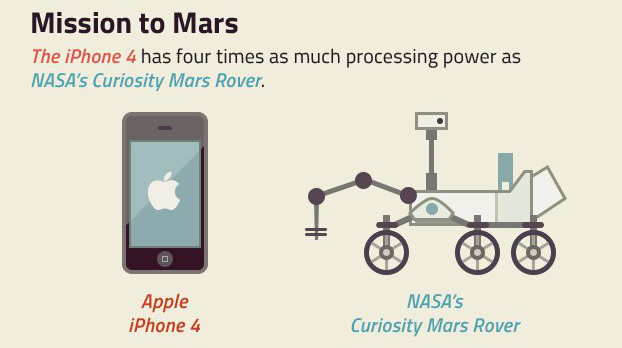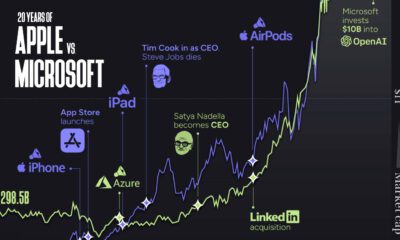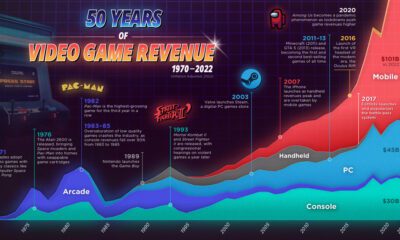Technology
The Supercomputer In Your Pocket

The Supercomputer in Your Pocket
We have mentioned here many times that the exponential rise in technology creates unprecedented opportunities for investors. Smaller and faster computers have led to emerging fields such as big data, the internet of things, cybersecurity, and the mobile payments revolution.
It all stems from Moore’s Law, which is based on observations made as early as 1965 by Gordon E. Moore, the co-founder of Intel. Moore suggested that the number of transistors in a dense integrated circuit would double approximately every two years, creating an exponential rise in computing potential.
However, for many this whole “exponential” thing is hard to wrap our heads around. Most of our daily observations are on a linear level, meaning that relationships hold true at a fixed rate. For example, if one wishes to bake a chocolate cake that is twice the size as a given recipe, the ingredients are to be doubled. If one is buying three cartons of milk from the grocery store, the cost will be three times higher.
Exponential Growth
Here’s an example of an exponential situation that just doesn’t feel intuitive. For the full version, which is worth reading, go to Peak Prosperity as they explain the compounding problem. Otherwise I will paraphrase:
Imagine that you are in Fenway Park, that the stadium is watertight, and you are handcuffed to the very highest bleacher seats. Meanwhile a drop of water is dropped on the pitcher’s mound, and the amount of water dropping will double every minute. How long do you have to escape from the handcuffs before drowning? Minutes, hours, days, years?
The answer turns out to be 49 minutes. Even more interesting is that most people wouldn’t be aware of how dire the situation until about 45 minutes, when the stadium is about 7% full of water and about to double yet again.
This example illustrates exponential growth. Applied to technology, it means that even though we have seen big advances over the last few decades with the emergence of personal computers, smartphones, and even smaller connected devices, the best is still yet to come.
Quantum computing and general artificial intelligence are approaching us faster than we may know.
Original graphic by: Fonebank
Technology
All of the Grants Given by the U.S. CHIPS Act
Intel, TSMC, and more have received billions in subsidies from the U.S. CHIPS Act in 2024.

All of the Grants Given by the U.S. CHIPS Act
This was originally posted on our Voronoi app. Download the app for free on iOS or Android and discover incredible data-driven charts from a variety of trusted sources.
This visualization shows which companies are receiving grants from the U.S. CHIPS Act, as of April 25, 2024. The CHIPS Act is a federal statute signed into law by President Joe Biden that authorizes $280 billion in new funding to boost domestic research and manufacturing of semiconductors.
The grant amounts visualized in this graphic are intended to accelerate the production of semiconductor fabrication plants (fabs) across the United States.
Data and Company Highlights
The figures we used to create this graphic were collected from a variety of public news sources. The Semiconductor Industry Association (SIA) also maintains a tracker for CHIPS Act recipients, though at the time of writing it does not have the latest details for Micron.
| Company | Federal Grant Amount | Anticipated Investment From Company |
|---|---|---|
| 🇺🇸 Intel | $8,500,000,000 | $100,000,000,000 |
| 🇹🇼 TSMC | $6,600,000,000 | $65,000,000,000 |
| 🇰🇷 Samsung | $6,400,000,000 | $45,000,000,000 |
| 🇺🇸 Micron | $6,100,000,000 | $50,000,000,000 |
| 🇺🇸 GlobalFoundries | $1,500,000,000 | $12,000,000,000 |
| 🇺🇸 Microchip | $162,000,000 | N/A |
| 🇬🇧 BAE Systems | $35,000,000 | N/A |
BAE Systems was not included in the graphic due to size limitations
Intel’s Massive Plans
Intel is receiving the largest share of the pie, with $8.5 billion in grants (plus an additional $11 billion in government loans). This grant accounts for 22% of the CHIPS Act’s total subsidies for chip production.
From Intel’s side, the company is expected to invest $100 billion to construct new fabs in Arizona and Ohio, while modernizing and/or expanding existing fabs in Oregon and New Mexico. Intel could also claim another $25 billion in credits through the U.S. Treasury Department’s Investment Tax Credit.
TSMC Expands its U.S. Presence
TSMC, the world’s largest semiconductor foundry company, is receiving a hefty $6.6 billion to construct a new chip plant with three fabs in Arizona. The Taiwanese chipmaker is expected to invest $65 billion into the project.
The plant’s first fab will be up and running in the first half of 2025, leveraging 4 nm (nanometer) technology. According to TrendForce, the other fabs will produce chips on more advanced 3 nm and 2 nm processes.
The Latest Grant Goes to Micron
Micron, the only U.S.-based manufacturer of memory chips, is set to receive $6.1 billion in grants to support its plans of investing $50 billion through 2030. This investment will be used to construct new fabs in Idaho and New York.
-

 Brands6 days ago
Brands6 days agoHow Tech Logos Have Evolved Over Time
-

 Economy2 weeks ago
Economy2 weeks agoWhere U.S. Inflation Hit the Hardest in March 2024
-

 Green2 weeks ago
Green2 weeks agoTop Countries By Forest Growth Since 2001
-

 United States2 weeks ago
United States2 weeks agoRanked: The Largest U.S. Corporations by Number of Employees
-

 Maps2 weeks ago
Maps2 weeks agoThe Largest Earthquakes in the New York Area (1970-2024)
-

 Green2 weeks ago
Green2 weeks agoRanked: The Countries With the Most Air Pollution in 2023
-

 Green2 weeks ago
Green2 weeks agoRanking the Top 15 Countries by Carbon Tax Revenue
-

 Markets2 weeks ago
Markets2 weeks agoU.S. Debt Interest Payments Reach $1 Trillion













